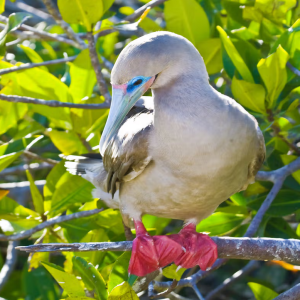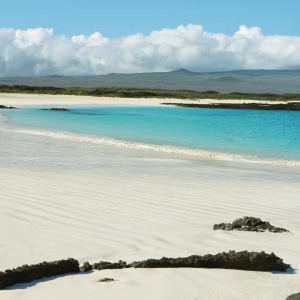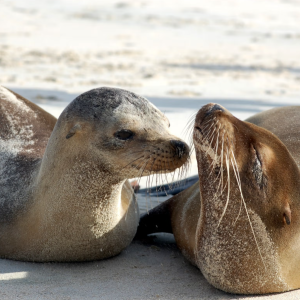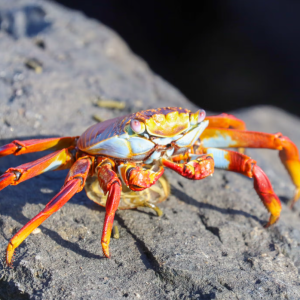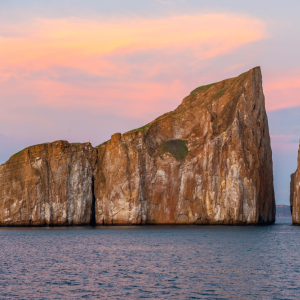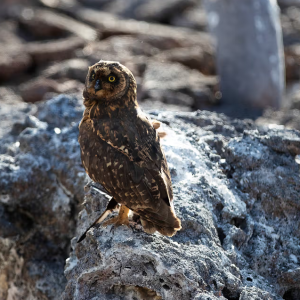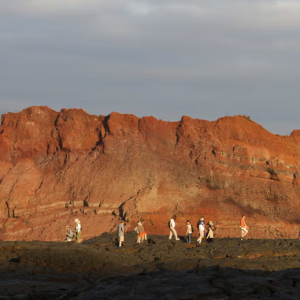7-Day Galapagos Cruise
Silversea | 7 Days | Roundtrip San Cristóbal
March 14-21, 2026
Nestled a staggering 600 miles from mainland Ecuador, the remote Galápagos is one of the most stunning regions on the planet. Join Silversea aboard Silver Origin to explore the archipelago in style. Embark from San Cristóbal and cruise between the islands taking in iconic highlights such as the Santa Cruz Highlands, where you’ll meet the Giant Tortoise up close. You’ll fall in love with the local wildlife by day and sip champagne under a blanket of stars by night.
AAA Member Benefits and Special Offers:
- Member Benefits
- Up to $300 per person onboard credit on select sailing dates
Your Ship: Silver Origin
Door-to-Door
For a relaxing, seamless journey from the moment you depart home, this fare includes airfare, transfers, and shore excursions.
- Pre & Post Cruise Benefits
- Private Executive Transfers
- International Flights
- Airport transfers
- Hotel
- In-country flights
- All Onboard Luxury Inclusions
- Food and beverages
- Butler service
- Expedition gear
- Shore excursions
Port-to-Port
For those who prefer to manage their own airfare and transfers, but still want included shore excursions, this fare is for you.
- Pre & Post Cruise Benefits
- Hotel
- In-country flights
- All Onboard Luxury Inclusions
- Food and beverages
- Butler service
- Expedition gear
- Shore excursions
Day 1 (MAR 14): San Cristóbal, Galapagos, Ecuador
Like so many of the islands in the Galapagos, San Cristobal is formed by dormant volcanoes. It lies to the east of the archipelago and is one of the oldest islands in the group. Approximately 8,000 people live on the island, making their living from tourism, fishing, in government offices, or off the rich volcanic soils with some limited farming existing in the highlands. Puerto Baquerizo Moreno on the southwestern tip of the island is the capital city of the Galapagos Islands. A statue of Charles Darwin graces the harbor, marking one of the first places he likely stepped ashore in the 1830s.
Day 1 (MAR 14): Kicker Rock, Ecuador
Kicker Rock is the vertical remnant of a former tuff cone less than 5 kilometers to the west of San Cristobal. Both its Spanish name "Leon Dormido" (Sleeping Lion) and English name Kicker Rock imply that it is one rock only -when in fact it is a larger one 300 meters long by 100 meters wide with a maximum height of approximately 150 meters and next to it an obelisk-like rock separated by a narrow channel some 20 meters deep. When approaching Kicker Rock, Blue-footed Boobies, Nazca Boobies, and frigatebirds can be observed in the air, while sea lions can be seen along the shore. Snorkelers and divers have reported manta rays, hammerhead sharks, and turtles. The Spanish name implies that the geological formation seen from the south resembles a sleeping lion.
Day 2 (MAR 15): Prince Philip's Steps, Genovesa, Ecuador
Genovesa is one of the northernmost islands of the archipelago. Genovesa's southern side of the shield volcano's crater collapsed, and a protected bay known as Darwin Bay was formed. The island is often referred to as the "Bird Island" as the numbers and species of land and seabirds on Genovesa are quite extraordinary. There are two visitor sites, and Prince Philip's Steps give access to the flat plateau above the bay. Named after Prince Philip who visited the Galapagos on two occasions, the "steps" are mostly natural. The steep cliffs are home to Red-billed Tropicbirds, while Magnificent Frigatebirds, Nazca, and Red-footed Boobies prefer the top. The plateau above Prince Philip's Steps has a palo santo forest and an extensive lava field. This is an area where one of the Galapagos's top predators, the Short-eared Owl, is hunting storm petrels. The Short-eared Owls are extremely well camouflaged and are not always easy to spot in between the rocks.
Day 2 (MAR 15): Darwin Bay, Genovesa, Ecuador
At Genovesa Island the ship tucks into Darwin Bay, an ancient volcanic crater now flooded by the sea. Zodiacs land on a picturesque sandy beach where Galapagos sea lions often rest on the fine, white sand. Explorations along the shore may reveal marine iguanas looking like prehistoric dinosaurs in miniature. By heading inland a short distance visitors could encounter seabirds of all shapes and sizes nesting in the vegetation. Scores of immature Red-footed Boobies perch on branches within an arm's reach of the path. In addition, watch for Great Frigatebirds and Yellow-crowned Night Herons along the walk. There is also fantastic snorkeling in the waters of Darwin Bay with the opportunity to see large schools of reef fish and brightly colored sea stars.
Day 3 (MAR 16): North Seymour, Ecuador
The landing at North Seymour Island is onto black lava rock. After a short climb, visitors arrive on the island's flat plateau where a number of sea lions nurse pups and frigatebirds nest. The island is dry, and so the predominant tree is the prickly pear cactus favored by the Galapagos land iguanas that live here in number. The undulating terrain is littered with red-brown volcanic boulders and large male Magnificent Frigatebirds can be seen inflating their vivid red gular sacs in hopes of impressing females flying overhead. At certain times of the year, pairs of Blue-footed Boobies dance here in a ritualized mating dance that reinforces their pair bond and shows off their vivid blue feet. The snorkeling here is well-known for schools of colorful creole wrasses and parrot fish.
Day 3 (MAR 16): Sullivan Bay (Santiago), Ecuador
The lava fields of Sullivan Bay on Santiago Island will inevitably remind visitors of the surface of the moon. As brilliant red Sally Lightfoot crabs scuttle along the black volcanic shores, learn about the formation of the islands through geological forces from your guides. The lava flows here are just over one hundred years old and date back to 1897. The lava took on a rope-like appearance and geologists have adopted a Hawaiian word, pahoehoe, as the technical name for this kind of volcanic rock.
Day 4 (MAR 17): Bolivar Canal Cruising, Ecuador
Like arriving at the remote and mysterious shores of a distant planet, the Bolivar Canal slices between two islands to the northwest of this spectacularly diverse archipelago. Discover the marine treasures of one of the world’s most fascinating stretches of water. The Galapagos Islands are alive with dramatic biodiversity - a spectacular combination of pristine isolation and productive ocean currents creates waters rich with life, large and small. The Bolivar Canal’s currents guide you into the heart of the archipelago from the remote Pacific, with the scenic waterway cutting between the active shield volcano of Isla Fernandina and the seahorse-shaped Isla Isabela. Wildlife - including the famous blue-footed boobies - gathers on the layered volcanic shores. Beneath the surface, a world of color and life swirls, and the seabed blooms with geothermal hues and intense biodiversity. These waters are rich with a feast of plankton, drawing in larger species in vast numbers, and the channel serves as the entry point for an extraordinary congregation of marine life from the depths of the Pacific - from whales and dolphins to turtles and rays. Experience the startling beauty and remarkable features of this unforgettable stretch. Silversea’s expert team is on hand throughout to share insights and expertise.
Day 4 (MAR 17): Punta Mangle, Fernandina, Ecuador
Among the impressive new lava fields of Fernandina Island hides a cove surrounded by mangroves. A rewarding place for bird-watching as the bay is the point where the land meets the sea, joining the two environments, with sea birds, shorebirds, and land birds all in the same place. The different species of mangroves: Red, White, and Black, have formed a root system that serves as a nursery for many species of fish, including juveniles’ sharks and green sea turtles. Snorkeling is as rewarding with some unique sightings such as Marine Iguanas feeding on algae, or flightless cormorants diving for their prey.
Day 4 (MAR 17): Punta Moreno, Isabela, Ecuador
This impressive and vast Pahoehoe black lava field is located on the south coast of Isabella Island and lies between two soaring active volcanoes, Sierra Negra and Cerro Azul, which you have a panoramic view of in the distance. Hike over huge other-worldly landscapes of corrugated lava which have been there for millennia. You can picture the lakes of hot lava as they poured from the mouth of the volcanoes now frozen in time. The rich blue waters of Cromwell Current wash the shores, and as a result, you can see the largest Marine Iguanas of the archipelago basking on the rocks. Watch Flightless Cormorants and Galapagos Penguins diving for food. Other wildlife to be found here includes Great blue Herons, White tipped Reef Sharks and look out for pelicans who nest in the emerald mangrove forest near the coastal lagoon.
Day 5 (MAR 18): Santa Cruz Highlands, Ecuador
Santa Cruz Island reaches a maximum altitude of 2,835 ft above sea level; at high altitudes, weather changes create microclimates. The species of flora and fauna found near the shoreline are extremely different from those on the highlands. Life in the highlands is much easier due to the presence of fresh water, from the constant drizzle that happens during the dry season to heavy rains that occur during the wet season. Local people take advantage of this climate to cultivate a large number of crops and giant tortoises love this ideal weather to mate, feed, and rest before their next long migration to the shorelines.
Day 5 (MAR 18): Fausto Llerena Breeding Center, Puerto Ayora (Santa Cruz), Ecuador
Silver Origin will anchor in front of Puerto Ayora, Santa Cruz, where the prestigious Charles Darwin Research Station is located. The station also houses the Fausto Llerena Breeding Center for giant tortoises and land iguanas where guides interpret the center's captive breeding and reintroduction programs. In addition to these star species, throughout the station there are huge prickly pear cactus trees being fed upon by the pretty Galapagos Cactus Finch. To round out the stay in Puerto Ayora, enjoy free time in town where local artists have created charming art galleries and corner cafes.
Day 6 (MAR 19): Gardner Bay, Española, Ecuador
Located on the northern coast of Española, the turquoise color water and white sandy beach stand out from far away. This beach is made out of pulverized shells and corals and offers a sandy patch of up to 1 kilometer in length. Española is considered one of the oldest in the Galapagos and has thus developed endemic species. Along the coast of Gardner a subspecies of colorful Marine iguanas are living among Hood Mockingbirds. The apex predators Galapagos Hawks commonly visit the coastline and a couple of times a Giant tortoise has been seen here.
Day 6 (MAR 19): Punta Suarez, Española, Ecuador
Punta Suarez lies at the western point of Española, the oldest island in the Galapagos. Sheer cliffs provide superb thermals for seabirds, and you may spot Swallow-tailed Gulls, Nazca Boobies, and Blue-footed Boobies on the breeze. The largest seabird to nest in the Galapagos Islands is the Waved Albatross. These ocean wanderers can be seen seasonally here from April through December, when pairs reunite on Española, going through an elaborate pair-bonding display. Mockingbirds, doves, and occasional Galapagos Hawks can also be seen on the point, along with sea lions and colorful marine iguanas.
Day 7 (MAR 20): San Cristobal, Isla Lobos, Ecuador
Isla Lobos, a tiny island sanctuary just offshore from San Cristobal, bustles with extraordinary wildlife, taking its name from its iconic resident sea lions, known as “lobos marinos” or “Marine Wolves” in Spanish. The sliver of land is an isolated wildlife haven, and a favorite hangout for the lumbering, loud, and loveable creatures. Arrive on the island to see dozens of the adorable sea lions flopping across the sandy shores, barking playfully, or snoozing the day away. You’ll often encounter more of the residents as you hike the terrain. Most notably, look out for the blue-footed boobies that strut along the coastline, unmistakable with their electric-blue feet. Magnificent frigatebirds are just as bold, and during mating season, males of the species puff out bright red pouches in a dramatic display of courtship. Fur seals may also be visible stretched out across the white-sand beaches, beside the narrow, protected channel that separates this island paradise from San Cristobal. Snorkel in the turquoise waters to encounter more underwater life, perhaps spotting stingrays, green turtles, or red-lipped batfish.
Day 7 (MAR 20): Cerro Brujo, San Cristóbal, Ecuador
An impressive tuff cone has been carved by erosion into an outstanding natural sculpture, being a resting place for marine birds such as blue-footed bobbies and brown pelicans. One of the most beautiful white sand beaches of the Galapagos (swim or snorkel). View sea lions, sally light footed crabs, blue-footed bobbies. Behind the dunes, you find a coastal lagoon, which was visited in the past by the locals to extract salt, today it is home to some shorebirds such as stilts and plovers.
Day 8 (MAR 21): San Cristóbal, Galapagos, Ecuador
Like so many of the islands in the Galapagos, San Cristobal is formed by dormant volcanoes. It lies to the east of the archipelago and is one of the oldest islands in the group. Approximately 8,000 people live on the island, making their living from tourism, fishing, in government offices, or off the rich volcanic soils with some limited farming existing in the highlands. Puerto Baquerizo Moreno on the southwestern tip of the island is the capital city of the Galapagos Islands. A statue of Charles Darwin graces the harbor, marking one of the first places he likely stepped ashore in the 1830s.
All pricing and offers for accommodations and other non-air travel are per person, based on double occupancy, capacity controlled and subject to availability and change without notice. Pricing does not include taxes, fees, fuel surcharges, gratuities, resort fees, or airfare unless otherwise noted and is valid on new bookings only. Prices, fees, and other restrictions are subject to supplier policies. All offers, including but not limited to, bonus amenities, upgrades, prices, and group benefits are based on select dates, resorts, room categories, and/or fare codes. Specialty pricing may require proper identification. Cancellation penalties, blackout dates, and other restrictions may apply. When traveling outside the United States a valid passport is required. It is the sole responsibility of the passenger to have the proper documentation and identification required by the United States and other governments at the time of travel. When passports are required, it must be valid for a minimum of six months past your date of return. AAA strongly recommends the purchase of Travel Insurance. Usage of a credit card for travel arrangements may provide additional protection, please consult your credit card policies. Under certain circumstances the package price may be subject to supplemental price increases imposed by the supplier. Price increases include, but are not limited to fuel surcharges, taxes or fluctuations in foreign exchange markets that may be imposed after the date of purchase. Air-inclusive prices do not include government imposed taxes and fees, including but not limited to a September 11th Security Fee, U.S. or international government imposed taxes and fees, Federal Excise Fees, among others. Some carriers charge additional fees for checked bags, fuel surcharge, meals, etc. Please check the carriers website for details. Air-inclusive pricing is based on select departure cities. Prices from other cities may vary. AAA Oregon/Idaho acts solely as a sales agent for travel suppliers and is not responsible for the actions or inactions of such suppliers. We monitor all of the information presented on our website; however, we do not assume responsibility for any errors or omissions in the content of the offers displayed. Review full Travel Disclosure and Consent at time of booking.
 Click Here to View Your Vacation
Click Here to View Your Vacation
